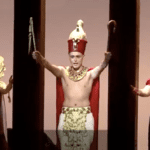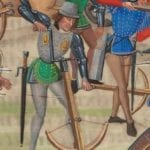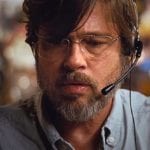 Technology
Technology  Technology
Technology  Humans
Humans 10 Everyday Human Behaviors That Are Actually Survival Instincts
 Animals
Animals 10 Animals That Humiliated and Harmed Historical Leaders
 History
History 10 Most Influential Protests in Modern History
 Creepy
Creepy 10 More Representations of Death from Myth, Legend, and Folktale
 Technology
Technology 10 Scientific Breakthroughs of 2025 That’ll Change Everything
 Our World
Our World 10 Ways Icelandic Culture Makes Other Countries Look Boring
 Misconceptions
Misconceptions 10 Common Misconceptions About the Victorian Era
 Mysteries
Mysteries 10 Strange Unexplained Mysteries of 2025
 Miscellaneous
Miscellaneous 10 of History’s Most Bell-Ringing Finishing Moves
 Technology
Technology Top 10 Everyday Tech Buzzwords That Hide a Darker Past
 Humans
Humans 10 Everyday Human Behaviors That Are Actually Survival Instincts
 Animals
Animals 10 Animals That Humiliated and Harmed Historical Leaders
Who's Behind Listverse?

Jamie Frater
Head Editor
Jamie founded Listverse due to an insatiable desire to share fascinating, obscure, and bizarre facts. He has been a guest speaker on numerous national radio and television stations and is a five time published author.
More About Us History
History 10 Most Influential Protests in Modern History
 Creepy
Creepy 10 More Representations of Death from Myth, Legend, and Folktale
 Technology
Technology 10 Scientific Breakthroughs of 2025 That’ll Change Everything
 Our World
Our World 10 Ways Icelandic Culture Makes Other Countries Look Boring
 Misconceptions
Misconceptions 10 Common Misconceptions About the Victorian Era
 Mysteries
Mysteries 10 Strange Unexplained Mysteries of 2025
 Miscellaneous
Miscellaneous 10 of History’s Most Bell-Ringing Finishing Moves
Top 10 Best Known Classical Melodies
If you think Classical music is boring, or that you don’t know enough about it to ever get your foot in the door, think again. Here are the 10 most well known melodies in Classical music history, and we guarantee that you have heard every single one of them already. You just may not have known their names or origins.
This is a particularly long overture to an opera, lasting about 12 minutes. It is in 4 parts (last part above), and the last three are very well known: a depiction of a storm, with a famous trombone passage; the morning after the storm, “a call to the cows,” and “a call to arms.” It is now said as a joke that a musicologist is someone who can listen to this finale and not think of The Lone Ranger, because the producers chose the finale as its theme. It’s primarily anapestic (short-short-LONG), which is an instant galloping horse rhythm.
This Overture wouldn’t be nearly as famous today, were it not for the Warner Brothers’ Looney Tunes cartoons. And you’re sure to see Bugs and Daffy and Porky and Elmer credited at least once more on this list. The storm and morning-after sections are in loads of Chuck Jones’s best works.
Take your talent on the road with the Casio CTK-2300 61-Key Premium Portable Keyboard Package at Amazon.com!
Everyone thought for centuries that Johann Sebastian Bach composed this minuet for his wife, Anna Magdalena, but he actually included it from Petzold into the notebook which bears her name. He never intended it to be thought of as his work. He intended the notebooks only for his wife, who had musical talent he wanted to cultivate. She often copied his scores for his orchestras. The pieces in the notebooks are comparatively easy to play, and the only reason we think of the piece as Bach’s work is because, on his death, his wife was so poor she sold all his manuscripts that she could find. Some went to butchers to wrap meat.
Every few years, a piece of music by Bach shows up in some dusty corner of a German church. Originals have even been found in America. But the minuet is not his. Petzold was a fairly popular composer in his day, slightly preceding Bach. He wrote the minuet sometime around 1721 and died in 1733. Bach wrote all the compositions in Notebook 1, and compiled other composers’ works into Notebook 2. It saved time and effort, and he never meant for them to be published. Not much of Petzold’s work has survived, but he was one of the finest organists in the world in his day, even third or second to Bach.
Inspired by Nietzsche’s treatise of the same name, Strauss wrote this tone poem in 1896, and it is in 9 parts. Almost no one is familiar with more than the first part, “Dawn” or “Sunrise.” It is world famous because of Stanley Kubrick’s sci-fi classic, 2001: A Space Odyssey. Elvis Presley also used it to open his concerts. It has been used in films, film trailers, and parodied so many times that even Ray Stevens, the country-comedy songwriter, used it once, with chickens “buck buck buck-AWing” the opening chords.
Beethoven isn’t typically thought of today, among musicologists, as a composer with the ability to compose lyrical melodies along the lines of the next entrant. Beethoven was able to make a mountain out of a molehill. He composed themes or motifs, and was the primary precursor to Richard Wagner’s leitmotifs. But, now and then, Beethoven sang out a melody to rival anyone’s. The final movement of his 9th Symphony is one of the most famous moments in musical history, and everyone in the civilized world can hum its tune.
In German, it is “Ode an die Freude,” a poem by Friedrich Schiller, and the poem might have been no more than just another Romantic poem, were it not for Beethoven’s musical setting of it. Now it is one of the most famous poems in world literature, because of him. Hector Berlioz argued that modern music began with this symphony. John Ruskin, the British essayist and critic, was not, however, as enthusiastic about it. He called the English premiere of it “a nerve-wracking hellish experience, full of India war-whoops, and finishing with a tune that sounds like Yankee Doodle.” Humorously enough, Yankee Doodle can be sung to this melody.
But Ruskin also thought William Wordsworth was a terrible poet. Not much of an accurate critic. The Ode to Joy is the definition of timeless. As long as there are people on Earth, some of them will be listening to it.
They say that listening to Beethoven makes you smarter. Find out with these 50 Must-Have Beethoven Masterpieces at Amazon.com!
This divertimento takes about 15 minutes to perform, and of its four, legendary movements, the first is, by far, the most well known. Milos Forman made good use of it, in his film Amadeus, as an example of how popular Mozart’s work is, even to those who don’t know he wrote it. Salieri plays a couple of his own melodies for a priest, who regrets that he doesn’t know them. Then Salieri plays the first few notes of this one and the priest finishes it for him. “I’m sorry. I didn’t know you wrote that!” he says.
“I didn’t,” Salieri replies with a look of utter disgust and contempt. “That was Mozart. Wolfgang Amadeus Mozart.”
You might be amazed to know that Mozart wrote this on commission from someone who needed “some happy music” for a ball. At the time, Mozart was sick with the flu. His wife, Constanza, was sick with the flu. They could barely afford food, and his father, Leopold, had just died. He was not in a happy mood, but he was not about to turn down the money. Some records indicate that he wrote the whole piece in a week. It was not published until 1827, long after he died.
Toccata means “touch” in Italian, indicating how lightly the fingers should perform such a work on a keyboard instrument. Toccatas have been written by almost every composer you can name, but this one is the one everyone knows. You may not know it by name, but when you hear it, you snap your fingers after the first 3 notes. The legend of its composition is that Bach was bored one day at the organ and played around until he came up with this melody. This is completely unsubstantiated. We have no idea of the origin of the work, and many musicologists have argued that he didn’t write it. This lister argues, however, that he did, because the fugue that accompanies this toccata is absolutely top-notch, and could not have been composed by anyone else, not even Handel. Bach is the all time master of the fugue, and this one ranks among his best.
The toccata is primarily famous through The Phantom of the Opera. The Phantom is often depicted seated at the underground organ playing this by himself. It has featured in a number of other films, too, including Disney’s Fantasia (1940), and is a byword in the horror film genre, now, especially Hammer Film Productions.
You may never have seen the operas of Wagner’s Der Ring des Nibelungen, but you’re sure to have seen, or at least heard of, What’s Opera, Doc? It’s the most famous, and some say the greatest of the Warner Brothers cartoon shorts ever made. And that cartoon makes use of quite a bit of Wagner’s best known melodies (Merrie Melodies, indeed). The cartoon is also called “Kill the Wabbit,” thanks to Elmer Fudd, who chases Bugs Bunny through operatic sets of particular opulence.
The Ride of the Valkyries appears in the second of the four operas of the cycle, Die Walkure, at the beginning, when the daughters of Wotan (Odin) ride on horses through the skies to gather the slain from the battlefield and bring them to Valhalla. Brunnhilde breaks the rules when she rescues a living woman, Sieglinde, because she is pregnant. Brunnhilde names the unborn son Siegfried, who grows up to be the greatest warrior of human history (except, perhaps, for Achilles). The music is set to the Valkyries riding down out of the sky on horseback.
Handel wrote the entire Messiah oratorio in 24 days. He borrows from his own works quite liberally in it, and some melodies by other composers, but the immortal Hallelujah Chorus is entirely his. He claimed to have not heard it in his head, but in his ears, being played by the angels in Heaven, while he simply took it down on paper. Its text comes from the King James version of the Revelation, 19:6, 11:15, and 19:16. When Haydn heard it once, he said, “Handel is the master of us all.” It is so famous now, that it is usually performed at Christmas even though the chorus comes at the end of the Easter section.
The practice of standing when it is played is said to have originated with King George II, who, at the premiere, stood from his throne during this piece because he had a cramp in his leg. The rule is everyone else must stand in the King or Queen’s presence if s/he stands.
If you have ever been to a wedding, you have heard this piece. Wagner didn’t call it Here Comes the Bride, of course. In the opera Lohengrin, Elsa marries Lohengrin, and this is the music played as she proceeds in wedding dress to the chapel. It is now the standard repertoire for all weddings in the western world, and for that reason it has probably been heard at least once by absolutely everyone in the western world.
The opera does not end happily, though. One of the rules Elsa must not break is asking Lohengrin his name and origins, which, of course, she does, right after the wedding. Lohengrin immediately tells her that he is a knight of the Holy Grail and must now leave her. She dies of grief watching him float away, being towed by a swan. Well what did you expect in an opera? A happy ending?
Specifically, the opening two measures, of only four notes. The rhythm is precisely that of the letter V in Morse Code, and for that reason, it was a signal used by the Allies in WWII (what’s the German word for irony?). Everyone in the civilized world has heard it, probably more than once. The story of how Beethoven came up with it is legendary and most likely not true. He was trying to begin his 5th symphony but couldn’t think of a theme to start it. There was a knock at the door in the same rhythm as the theme and the rest is history. Why is this doubtful? Beethoven was almost 100% deaf by the time he started his 5th symphony, and wouldn’t have heard a knock at the door.
Another story is that he heard, or felt it, in a severe clap of thunder one afternoon while out walking. It remains the most performed melody in all of Classical music’s history. It has been incorporated into every 20th Century genre of music: rap, blues, disco, heavy metal, rock and roll, country, you name it.








